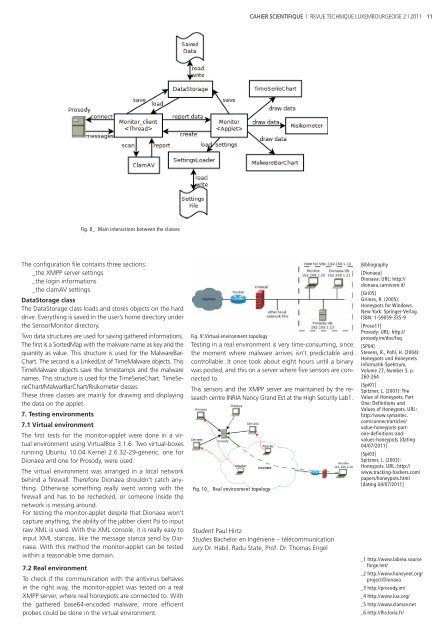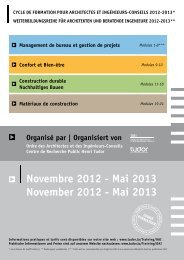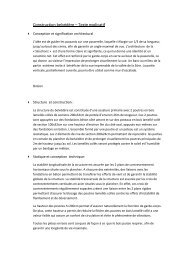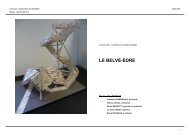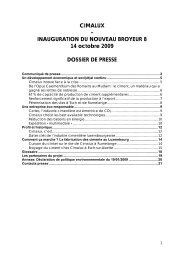Cahier Scientifique 02 | 2011 (PDF) - Revue Technique ...
Cahier Scientifique 02 | 2011 (PDF) - Revue Technique ...
Cahier Scientifique 02 | 2011 (PDF) - Revue Technique ...
Create successful ePaper yourself
Turn your PDF publications into a flip-book with our unique Google optimized e-Paper software.
CAHIER SCIENTIFIQUE | REVUE TECHNIQUE LUXEMBOURGEOISE 2 | <strong>2011</strong><br />
11<br />
Fig. 8_ Main interactions between the classes<br />
The configuration file contains three sections:<br />
_the XMPP server settings<br />
_the login informations<br />
_the clamAV settings<br />
DataStorage class<br />
The DataStorage class loads and stores objects on the hard<br />
drive. Everything is saved in the user’s home directory under<br />
the SensorMonitor directory.<br />
Two data structures are used for saving gathered informations.<br />
The first is a SortedMap with the malware name as key and the<br />
quantity as value. This structure is used for the MalwareBar-<br />
Chart. The second is a LinkedList of TimeMalware objects. This<br />
TimeMalware objects save the timestamps and the malware<br />
names. This structure is used for the TimeSerieChart. TimeSerieChart/MalwarBarChart/Risikometer<br />
classes<br />
These three classes are mainly for drawing and displaying<br />
the data on the applet.<br />
7. Testing environments<br />
7.1 Virtual environment<br />
The first tests for the monitor-applet were done in a virtual<br />
environment using VirtualBox 3.1.6. Two virtual-boxes<br />
running Ubuntu 10.04 Kernel 2.6.32-29-generic, one for<br />
Dionaea and one for Prosody, were used.<br />
The virtual environment was arranged in a local network<br />
behind a firewall. Therefore Dionaea shouldn’t catch anything.<br />
Otherwise something really went wrong with the<br />
firewall and has to be rechecked, or someone inside the<br />
network is messing around.<br />
For testing the monitor-applet despite that Dionaea won’t<br />
capture anything, the ability of the jabber client Psi to input<br />
raw XML is used. With the XML console, it is really easy to<br />
input XML stanzas, like the message stanza send by Dionaea.<br />
With this method the monitor-applet can be tested<br />
within a reasonable time domain.<br />
7.2 Real environment<br />
To check if the communication with the antivirus behaves<br />
in the right way, the monitor-applet was tested on a real<br />
XMPP server, where real honeypots are connected to. With<br />
the gathered base64-encoded malware, more efficient<br />
probes could be done in the virtual environment.<br />
Fig. 9: Virtual environment topology<br />
Testing in a real environment is very time-consuming, since<br />
the moment where malware arrives isn’t predictable and<br />
controllable. It once took about eight hours until a binary<br />
was posted, and this on a server where five sensors are connected<br />
to.<br />
This sensors and the XMPP server are maintained by the research<br />
centre INRIA Nancy Grand Est at the High Security Lab1.<br />
Fig. 10_ Real environment topology<br />
Student Paul Hirtz<br />
Studies Bachelor en Ingénierie – télécommunication<br />
Jury Dr. Habil. Radu State, Prof. Dr. Thomas Engel<br />
Bibliography<br />
[Dionaea]<br />
Dionaea: URL: http://<br />
dionaea.carnivore.it/<br />
[Gri05]<br />
Grimes, R. (2005):<br />
Honeypots for Windows.<br />
New York: Springer-Verlag.<br />
ISBN: 1-59059-335-9<br />
[Proso11]<br />
Prosody: URL: http://<br />
prosody.im/doc/faq<br />
[SP04]<br />
Stevens, R., Pohl, H. (2004):<br />
Honeypots und Honeynets.<br />
Informatik-Spektrum,<br />
Volume 27, Number 3, p.<br />
260-264<br />
[Spi01]<br />
Spitzner, L. (2001): The<br />
Value of Honeypots, Part<br />
One: Definitions and<br />
Values of Honeypots. URL:<br />
http://www.symantec.<br />
com/connect/articles/<br />
value-honeypots-partone-definitions-andvalues-honeypots<br />
[dating<br />
04/07/<strong>2011</strong>]<br />
[Spi03]<br />
Spitzner, L. (2003):<br />
Honeypots. URL: http://<br />
www.tracking-hackers.com/<br />
papers/honeypots.html<br />
[dating 04/07/<strong>2011</strong>]<br />
_1 http://www.labrea.source<br />
forge.net/<br />
_2 http://www.honeynet.org/<br />
project/Dionaea<br />
_3 http://prosody.im/<br />
_4 http://www.lua.org/<br />
_5 http://www.clamav.net<br />
_6 http://lhs.loria.fr/


